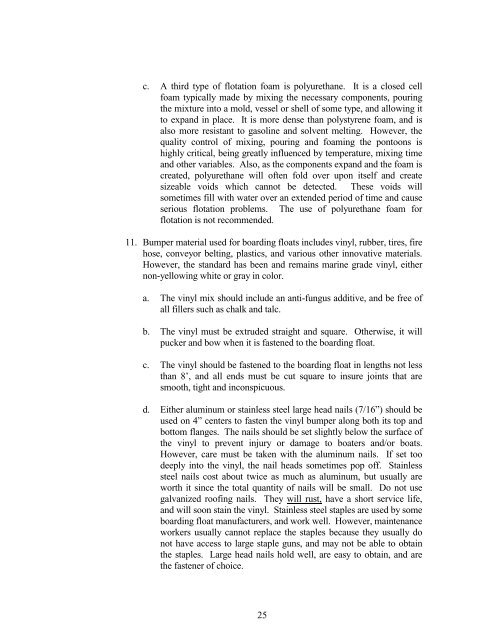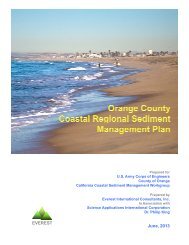layout, design and construction handbook - California Department of ...
layout, design and construction handbook - California Department of ...
layout, design and construction handbook - California Department of ...
Create successful ePaper yourself
Turn your PDF publications into a flip-book with our unique Google optimized e-Paper software.
c. A third type <strong>of</strong> flotation foam is polyurethane. It is a closed cell<br />
foam typically made by mixing the necessary components, pouring<br />
the mixture into a mold, vessel or shell <strong>of</strong> some type, <strong>and</strong> allowing it<br />
to exp<strong>and</strong> in place. It is more dense than polystyrene foam, <strong>and</strong> is<br />
also more resistant to gasoline <strong>and</strong> solvent melting. However, the<br />
quality control <strong>of</strong> mixing, pouring <strong>and</strong> foaming the pontoons is<br />
highly critical, being greatly influenced by temperature, mixing time<br />
<strong>and</strong> other variables. Also, as the components exp<strong>and</strong> <strong>and</strong> the foam is<br />
created, polyurethane will <strong>of</strong>ten fold over upon itself <strong>and</strong> create<br />
sizeable voids which cannot be detected. These voids will<br />
sometimes fill with water over an extended period <strong>of</strong> time <strong>and</strong> cause<br />
serious flotation problems. The use <strong>of</strong> polyurethane foam for<br />
flotation is not recommended.<br />
11. Bumper material used for boarding floats includes vinyl, rubber, tires, fire<br />
hose, conveyor belting, plastics, <strong>and</strong> various other innovative materials.<br />
However, the st<strong>and</strong>ard has been <strong>and</strong> remains marine grade vinyl, either<br />
non-yellowing white or gray in color.<br />
a. The vinyl mix should include an anti-fungus additive, <strong>and</strong> be free <strong>of</strong><br />
all fillers such as chalk <strong>and</strong> talc.<br />
b. The vinyl must be extruded straight <strong>and</strong> square. Otherwise, it will<br />
pucker <strong>and</strong> bow when it is fastened to the boarding float.<br />
c. The vinyl should be fastened to the boarding float in lengths not less<br />
than 8’, <strong>and</strong> all ends must be cut square to insure joints that are<br />
smooth, tight <strong>and</strong> inconspicuous.<br />
d. Either aluminum or stainless steel large head nails (7/16”) should be<br />
used on 4” centers to fasten the vinyl bumper along both its top <strong>and</strong><br />
bottom flanges. The nails should be set slightly below the surface <strong>of</strong><br />
the vinyl to prevent injury or damage to boaters <strong>and</strong>/or boats.<br />
However, care must be taken with the aluminum nails. If set too<br />
deeply into the vinyl, the nail heads sometimes pop <strong>of</strong>f. Stainless<br />
steel nails cost about twice as much as aluminum, but usually are<br />
worth it since the total quantity <strong>of</strong> nails will be small. Do not use<br />
galvanized ro<strong>of</strong>ing nails. They will rust, have a short service life,<br />
<strong>and</strong> will soon stain the vinyl. Stainless steel staples are used by some<br />
boarding float manufacturers, <strong>and</strong> work well. However, maintenance<br />
workers usually cannot replace the staples because they usually do<br />
not have access to large staple guns, <strong>and</strong> may not be able to obtain<br />
the staples. Large head nails hold well, are easy to obtain, <strong>and</strong> are<br />
the fastener <strong>of</strong> choice.<br />
25




